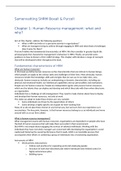Samenvatting
Samenvatting Strategy and Human Resource Management, ISBN: 9780333778203 Strategisch Human Resource Management FSWBM-6060 (FSWBM-6060)
- Instelling
- Erasmus Universiteit Rotterdam (EUR)
Samenvatting van hoofdstuk 1 t/m 4, 7, 9 en 12 van 'Strategy and Human Resource Management' fifth edition. Dit zijn ook de hoofdstukken die verplicht zijn volgens de vakwijzer in collegejaar .
[Meer zien]





